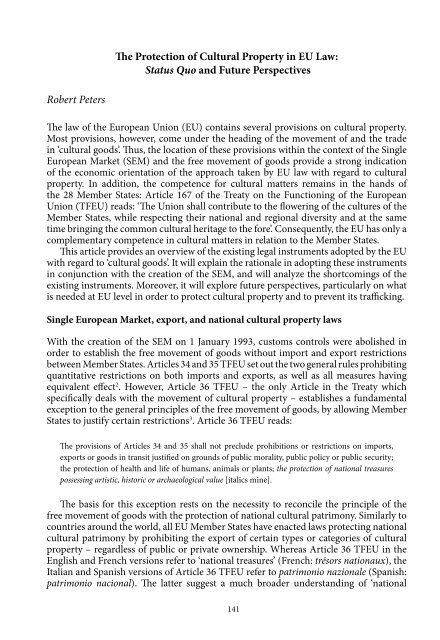Countering
Book_observatory_illicit_traffic_version%20issuu
Book_observatory_illicit_traffic_version%20issuu
Create successful ePaper yourself
Turn your PDF publications into a flip-book with our unique Google optimized e-Paper software.
Robert Peters<br />
heritage’ or ‘national patrimony’ than the term ‘national treasures’ – which indicates that<br />
the provisions might be limited to few precious items. These terminological differences<br />
imply that the legal concept underlying the conceptualization of cultural property may<br />
vary as well. Similarly to UN Treaty law, the EU Treaty does not grant supremacy to<br />
one language over the other. Rather, the texts of all official languages are authentic. It is<br />
important to note that while the UN has six official languages, the EU has 24 4 .<br />
The present article focuses on EU provisions on cultural property, rather than a<br />
discussion of the effects of language discrepancy on principles of EU treaty interpretation.<br />
That said, the German text of the EU Treaty may help to reconcile this disparate<br />
understanding of the concept, at least for the purpose of this article. The German text<br />
speaks of nationales Kulturgut, which simply refers to ‘national cultural goods’ (or<br />
‘national cultural property’) and thus offers an in-between concept. In addition, the<br />
UNESCO 1970 Convention 5 – the major international convention on the protection of<br />
movable cultural property against illicit import, export and transfer of ownership – with<br />
currently 129 States Parties – uses the concept of ‘cultural property’ in a similar acception<br />
within its statutory provisions 6 . This analysis aims to demonstrate that the concept of<br />
‘national treasures’ in the English and French versions of Article 36 TFEU is too narrow.<br />
Several Member States, with a very rich archeological past, such as Italy and Greece, have<br />
a relatively high level of legal protection for national cultural property. Others, including<br />
many Member States in Northern Europe, offer less protection and provide a narrower<br />
definition of the types of artwork considered to be national cultural property. As a result,<br />
these Member States also restrict exportation to a lesser degree.<br />
Bearing in mind that the competence for cultural matters lies with the EU Member<br />
States, this analysis concludes that the definition of what ‘national cultural property’<br />
encompasses under Article 36 TFEU also falls entirely within the competence of each<br />
Member State, and thus reflects its own conception of what should be protected as<br />
‘national cultural property’. The same applies to the UNESCO 1970 Convention, which<br />
states that ‘for the purposes of this Convention, the term ‘cultural property’ means<br />
property which, on religious or secular grounds, is specifically designated by each State<br />
as being of importance for archaeology, prehistory, history, literature, art or science’<br />
(Article 1) the loss of which would constitute ‘the impoverishment of the cultural<br />
heritage’ (Article 2) of that State. However, it is completely with the sovereignty of the<br />
State to designate what constitutes its national cultural property.<br />
As a consequence, it is fundamental for States – EU Member States and States Parties<br />
to the 1970 UNESCO Convention alike – to control the import and export of cultural<br />
property. This is usually accomplished through border and customs controls. In times<br />
of war, political unrest or a failed State, the weakening or absence of these controls is<br />
frequently correlated with enormous increases in the trafficking in cultural property.<br />
By deliberately relinquishing customs control among Member States, the creation of the<br />
SEM has a remarkably similar effect, because it undermines the States’ right to carry out<br />
export controls at national borders. In order to compensate the abolition of national<br />
customs controls within the SEM (more specifically, the Schengen area), the EU adopted<br />
in 1992 Regulation 3911/92 on the export of cultural goods 7 . This regulation is intended<br />
to ensure that the export of national cultural property outside the SEM became subject<br />
to uniform export controls at the EU’s external borders.<br />
While the 1992 EU Regulation was subsequently codified by Regulation 116/2009,<br />
the conversion did not make major modifications to its contents 8 . However, since<br />
a regulation is a legal act of the EU having general application and being binding in<br />
142


